How to make a non-return valve for ventilation with your own hands: instruction on the construction of a homemade product
The main purpose of the ventilation system is to ensure the influx of fresh air into the room, while simultaneously removing the exhaust air masses. However, quite often it happens that the ventilation system does not cope with its direct responsibility, which is why instead of clean air, odors from neighboring apartments and the entrance penetrate into the housing.
The only solution is to install a check valve to ensure proper ventilation. Agree, it is somewhat impractical to spend money on the purchase of a structure that you can build yourself. Based on step-by-step instructions, you can make a check valve for ventilation with your own hands using improvised means.
Further in the article will be presented the most common types of check valves, the features of their installation and the selection of a suitable design for the apartment. Having understood the principle of operation and design features of the non-return valve, you can independently construct the structure and install it.
The content of the article:
The principle of the check valve
The valve design is a protective device to prevent the appearance of ventilation back draft in the apartment. By letting fresh air flow in the desired direction, the valve inhibits the reverse flow.
The main advantage of the design is its automatic operation.
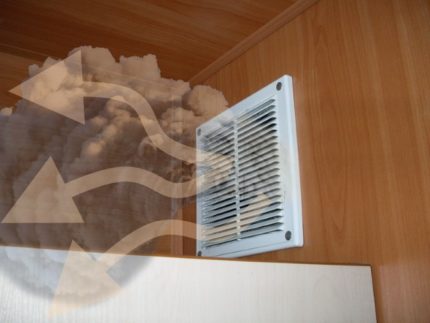
In ventilation systems valve prevents air from the general ventilation duct into individual rooms. Such designs work in systems with both natural and mechanical traction.
Similar situations may arise due to the following problems:
- incorrect installation of the exhaust pipe;
- insufficient intake of fresh air into the system;
- forced ventilation installation in one of the apartments;
- check valve malfunction.
The main structural element of the check valve is the shutter. When the valve is installed correctly, the valve must open in only one direction under air pressure.
When air moves not from the room, but inside it, the shutter automatically closes.
Design features of the check valve
Often check valves are made in the form of a disk, while they can be of different sizes and cross-sectional configurations.
If necessary, the device can be equipped with heating, however, it is only suitable for a ventilation system with an electric drive. The main advantage of a heated valve is to prevent the formation of condensate in the system, and therefore, ice in the cold season.
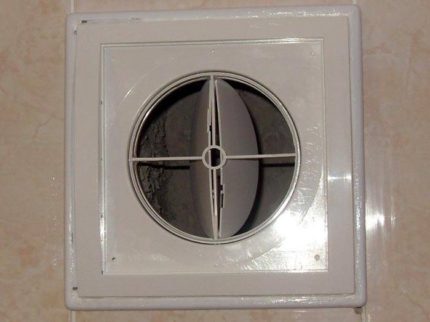
In today's market, there are only four main types of check valve design. Each of them has its pros and cons, which should be taken into account when choosing a particular design for its ventilation system.
Option No. 1 - single-leaf design
The design is a damper mounted on a horizontal axis, which, under the influence of air flow, opens and closes the passage. So, the exhaust air is removed into the exhaust part of the system.
If there is no air movement inside the room or when there is a return draft, the valve flap will not open.
A single-leaf valve is most suitable for use in natural ventilation of the room, since even a minimum air flow is sufficient to open the valve.
Such a design, in turn, can be of two types. In the first case, the axis on which the shutter is mounted is mounted with an offset relative to the center of the air channel, and in the other, a counterweight is placed inside and outside.
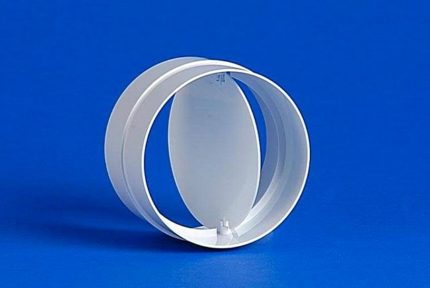
During vertical or horizontal installation, it is recommended to use a level. If installed incorrectly, the valve will not close properly, which will prevent it from protecting the room from backdraft.
If you install a single-leaf valve near the heating battery, the air coming from the street will immediately heat up. This will significantly increase the temperature level in the room, and therefore, reduce heating costs.
Option No. 2 - butterfly valve
Due to its principle of operation, such a valve is called a butterfly. In the center of the round hole there is an axis with two shutters, which are returned to their original position by means of small springs.
Installation of the “butterfly” does not require special preparations, since such a design can be installed at any angle.
Often, such devices are used in a forced ventilation system with a hood. When the mechanical hood is turned off, the valves equipped with springs return to their original position, tightly overlapping the entire section of the channel.
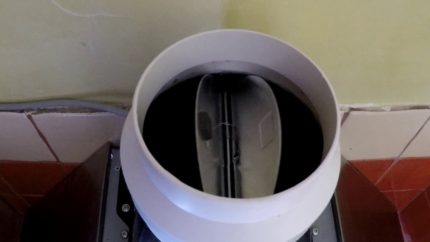
The only thing to do before installing the butterfly valve is to check the sensitivity of the curtains. If the air pressure in the ventilation duct is not enough for this design, it is better to choose a different type of valve.
This type of check valve is often installed in buildings with a large ventilation system.
Option number 3 - inertial valve
This type of valve is a special blinds that are placed on the ventilation grill. Like a single-leaf valve, the inertial design works according to the gravitational principle. The difference between these two designs is only in the number and size of the wings.
They rise freely, and change their angle depending on the strength of the air pressure. The blinds are lowered only under their own weight, which is possible only if the fan stops working.
Such a gravitational grate is installed with horizontal air movement. Like the butterfly, the inertia valve is mounted only in the forced ventilation system.
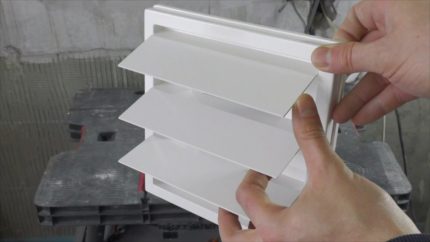
Basically, standard sizes of blinds are available on the market that are fully consistent with the size of the hood for hoods and openings for natural ventilation.
If necessary, such an exhaust valve can be built with your own hands, improving the functionality of the device using a spring or membrane.
Option No. 4 - diaphragm type valve
The device is a flexible plate, which bends under the influence of air flow. To open and close the valve, even a small influx is enough, but in this case a lot also depends on the correct installation of the structure.
By its principle of operation, the membrane valve resembles a “butterfly”, but with more modest characteristics.
Before installing a flexible membrane, consider back thrust in the ventilation duct, since there is a high probability of valve deformation.
In the presence of strong traction, it is better to choose any other type of design in order to protect yourself from the additional cost of effort and money. In this case, everything depends on the size of the room and the strength of the air flow.
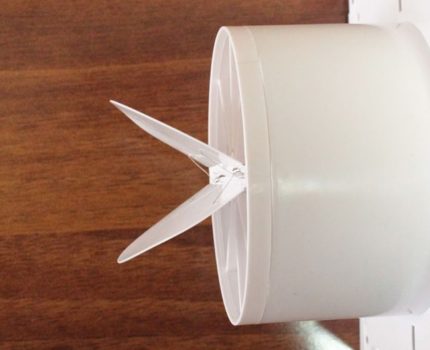
Diaphragm type check valve - ideal for small houses and porches. Unlike the previous three valves, the membrane type can be built independently, without the help of a master.
The next section will provide detailed instructions that will help you make a non-return valve yourself.
Self-Valve Instruction
As you already understood, in order to create a ventilation system with protection against back draft it is not necessary to buy a finished construction. Of course, you can’t completely manage without costs, since you have to buy exhaust fan. It will become the basis for the check valve.
Before starting work, you should prepare all the necessary tools and materials. So, to build a membrane valve, you will need a piece of plastic and a thick plastic film. It is also important to immediately prepare a drill, screws, rubber pads and glue.
To understand how to make a non-return valve for ventilation yourself, it is important to read the following instructions.
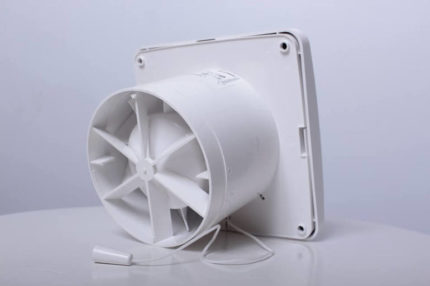
We cut out the plate from dense plastic strictly according to the shape of the opening of the ventilation duct. Actually, this will be the basis of the future valve.
Then at the edges we drill several holes for attaching the panel to the wall and fixing the fan. The number of holes can be adjusted independently.
In the center of the plate, we also drill several holes through which exhaust air will be discharged. You will also have to determine their number yourself, based on personal needs.The more holes in the center of the plate, the greater the throughput of the valve.
Next, we fix the hood to the finished base. To begin with, you will need to install a rubber gasket at the junction, and only after that it will be possible to fix the fan. This will provide the necessary tightness, and therefore, improve the quality of the valve.
To avoid annoying noise emanating from the fan during operation, it is recommended to place small pieces of rubber under the fixture of the device.

We make sashes for the valve from a thick plastic film. First of all, you need to cut the film to the size of the base, and only after that stick to the base of the valve. Please note, the sashes must completely close. vents.
The next step is to cut the sash into two identical parts, while it is important that the cut is as even as possible. In this case, it is recommended to use a clerical knife with a sharp blade.
We install the finished valve into the ventilation duct, fixing it to the wall with several screws. Since there are gaps between the wall and the valve, it is advisable to get rid of them immediately with sealant.
This completes the process of creating and installing a membrane valve. With the consistent implementation of all of the above actions, you should get a reliable device that protects the room from backdraft.
Conclusions and useful video on the topic
This video provides step-by-step instructions for self-construction of a membrane valve for ventilation in an apartment:
To independently build a check valve for ventilation and save on the purchase of a finished product is now quite realistic. In this case, it is important to decide on the type of valve in advance, purchase an exhaust fan and start manufacturing a home-made design.
A prerequisite is the preservation of the sequence of steps presented in the above instructions.
If you are already familiar with the process of constructing a check valve, or if you know a simpler method that allows you to make a design with minimal cost, then please share your experience with our readers.
Leave your comment in the special field under the article, and if desired, ask questions to our experts.

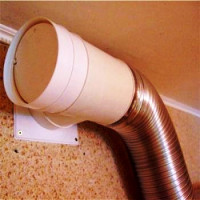 Check valve for ventilation: how to arrange ventilation with a check valve on the hood
Check valve for ventilation: how to arrange ventilation with a check valve on the hood 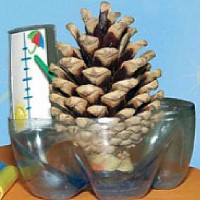 Do-it-yourself air humidity meter: assembly instructions for the hygrometer
Do-it-yourself air humidity meter: assembly instructions for the hygrometer  How to make a fan yourself: the best options for homemade
How to make a fan yourself: the best options for homemade 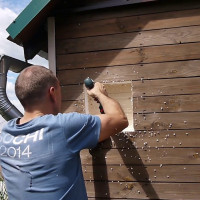 How to make ventilation in an animal shed: requirements and nuances of arranging ventilation
How to make ventilation in an animal shed: requirements and nuances of arranging ventilation 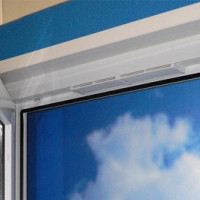 Supply valve on plastic windows: how to choose and install a ventilation valve
Supply valve on plastic windows: how to choose and install a ventilation valve  How to clean the ventilation in the apartment with your own hands: suitable tools and work procedures
How to clean the ventilation in the apartment with your own hands: suitable tools and work procedures  How much does it cost to connect gas to a private house: the price of organizing gas supply
How much does it cost to connect gas to a private house: the price of organizing gas supply  The best washing machines with dryer: model rating and customer tips
The best washing machines with dryer: model rating and customer tips  What is the color temperature of light and the nuances of choosing the temperature of the lamps to suit your needs
What is the color temperature of light and the nuances of choosing the temperature of the lamps to suit your needs  Replacement of a geyser in an apartment: replacement paperwork + basic norms and requirements
Replacement of a geyser in an apartment: replacement paperwork + basic norms and requirements